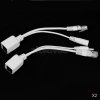I have 11 cameras which I want to install in our office location. 10 of these cameras are Realink cameras and 1 is a Q-See camera which I will be connecting to a Q-SEE NVR which has a hard drive in it. With these cameras I am going to be running a total of 500+ feet in total of Ethernet cable so I will be buying the 1000 Ft cable.
I came across someone that told me that I can tap into the power from the Ethernet Cable so that I do not have to run two wires one for power and one for Ethernet. I was looking around and found out that there are 4 unused wires in a Ethernet cable , would these 4 be able to provide power to the camera? If so does it provide power automatically or do I need to connect the remaining 4 to a power adapter that connect to the end of the camera as to avoid connecting it to a power outlet?
I came across someone that told me that I can tap into the power from the Ethernet Cable so that I do not have to run two wires one for power and one for Ethernet. I was looking around and found out that there are 4 unused wires in a Ethernet cable , would these 4 be able to provide power to the camera? If so does it provide power automatically or do I need to connect the remaining 4 to a power adapter that connect to the end of the camera as to avoid connecting it to a power outlet?

